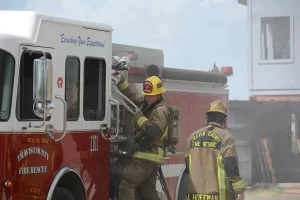Emergency Services Districts (ESDs) are local government units in Texas that provide fire protection, ambulance services, or both. They operate paid or volunteer departments and are independent political subdivisions, though closely tied to county governments.
Key Functions of ESDs
- Emergency Medical Services (EMS)
- Fire protection
- Combined fire and EMS in some cases
Where ESDs Operate
ESDs typically operate in rural and suburban areas. They may cover part of a county, a full county, or territory in one or more counties.
Some counties in Texas are home to numerous emergency services districts. Bexar County, for example, has 12 of them, and Harris County has more than 30. As of 2021, there were 340 emergency services districts in Texas in 90 counties.
By law, ESDs are allowed to overlap as long as they do not provide duplicative services. For example, one ESD could provide fire protection and another EMS services.
Funding Sources
- Property tax: ESDs can levy a property tax of up to 10 cents per $100 of property value. Any increase requires voter approval.
- Sales tax: Up to 2% with voter approval.
- Service fees: Some ESDs charge services fees, e.g. for ambulance transport.
- Grants: State or federal assistance for equipment or services.
Structure and Oversight
Each ESD is governed by a board of five commissioners appointed by the county commissioners court, except in a handful of counties were ESD boards are elected. Commissioners serve staggered, two-year terms.
This arrangement links ESDs closely to county governments, even though ESDs are technically independent political subdivisions.
Each year, ESDs are required by law to file an audit with their county commissioners court. If they fail to do so within three months of a June 1 deadline, the president and treasurer of the ESD board are automatically removed from their offices. However, under an exception in the law, smaller ESDs may be allowed to file certified financial statements instead of an audit.

ESDs are also required by law to file an annual report with the Texas Department of Agriculture. ESDs are subject to few other external oversight requirements. They are governed by chapter 775 of the Texas Government Code.
By law, ESD boards must meet at least once a month. All meetings are subject to the Texas Open Meetings Act, which means that they are generally open to the public.
Relationship to City Fire Departments
Emergency Services Districts are distinct from municipal fire and EMS services. An ESD cannot be formed within a municipality’s limits without the consent of the city council. Therefore, ESDs are more commonly formed in rural and suburban areas.
Historical Evolution
Emergency Services Districts in Texas have their origins in a constitutional amendment approved by voters in 1949. Farmers and rural property owners were concerned about property damage caused by fire and encouraged the Texas Legislature to propose a constitutional amendment allowing rural areas to create Rural Fire Protection Districts. These districts were allowed to levy a property tax at $0.03 percent $100 of property valuation.
By the late 1980s, population growth in rural areas and the move to becoming suburbs encouraged the examination of a better funded form of fire protection districts. In 1987, the Texas Legislature proposed a constitutional amendment creating Emergency Services Districts with broader powers and the ability to levy a higher tax. Voters in ESDs were able to approve a tax rate up to $0.10 by $100 valuation.
In 2003 and 2011, rural fire protection was consolidated as all Rural Fire Protection Districts were converted into Emergency Services Districts.
Comparison to Other States
Emergency Services Districts (ESDs) in Texas share similarities with systems in other states but also have notable differences:
| State | Equivalent Entity | Key Differences |
|---|---|---|
| California | Fire Protection Districts | Elected boards, rarely combined with EMS |
| Florida | Independent Special Fire Control Districts | Focus on fire only |
| Colorado | Fire/EMS districts | More local flexibility |
| New York | Fire Districts | Elected boards, tighter state oversight |
| Illinois | Township Fire Districts | More integrated with local government |
In summary, while many states have systems similar to Texas’s ESDs, the key differences lie in governance structures and whether fire and EMS services are combined or separate.
Process of Creating ESDs
By law, ESDs may be created through a three-step process. First, qualified voters who own property in the proposed area petition a county judge for the creation of the district.
Second, if the petition is valid and is signed by at least 100 qualified voters who own property within the proposed ESD, the county commissioners court must hold a hearing on the matter.
Third, if the commissioners court finds that the proposed ESD district is “feasible” and will promote the public welfare, it may submit the proposal to the voters for final approval.Elections to approve or rejected the creation of an ESD must be held on the first uniform election date after approval by the commissioners court.
Once an ESD is approved by the voters, the commissioners court appoints five members to the ESD board (except in counties where ESD boards are elected).
A similar process governs proposals for the dissolution of an ESD, the expansion of ESD boundaries, or the consolidation of two or more ESDs into one larger district.



